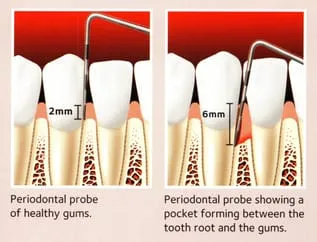Periodontal Disease is Also Known as Gum Disease - Periodontal disease is a bacterial infection leading to inflammation of the tissues that support your teeth. It's also called gum disease. When your gums are healthy, your gum tissues tightly hug each of your teeth. When you have gum disease, your gums pull away from your teeth. As the gum disease gets worse, the soft tissues and bone that support your teeth are damaged. Over time, your teeth may become loose, fall out or may need to be removed. Treating gum disease in the early stages is very important because it can help prevent tooth loss. Scaling and root planing is a type of deep cleaning treatment that your dentist may recommend for treating your gum disease.
Before Your Treatment - Causes of Gum Disease: Plaque is a sticky film in which bacteria grow that is always on your teeth. Dental plaque begins to re-form after a teeth cleaning. When left undisturbed, the plaque hardens into tartar, sometimes called dental calculus. Your body may react to the bacteria in plaque, resulting in inflammation of the gum tissue and bone that support your teeth. When your gums are red, puffy and swollen, they can start to pull away from your teeth. Spaces called periodontal pockets start to form between your gums and teeth. Bacteria collect in these pockets, and as it collects, your gum disease will get worse. The bacteria in the pockets produce toxins. Your body's response to the toxins causes the soft tissues and bone around your teeth to break down.
Checking for Gum Disease - Your dentist or hygienist uses an instrument called a periodontal probe to measure how deep the pockets are around each tooth. When your teeth are healthy, the pocket is usually 3 millimeters (mm) deep or less. Typically, the worse the disease, the deeper the pocket. This means bacteria have more room to grow and cause serious damage to your gums and bone, loosening your teeth. Very deep pockets are a sign of advanced periodontal disease. Dental x-rays are another tool used to check your teeth and the supporting bone. Bone loss can be a sign of damage from gum disease. All dentists are trained to detect, treat and monitor gum disease. But, your dentist may send you to a periodontist - a dentist who specializes in the treatment of gum disease.
During Your Treatment - Your gum disease treatment will depend on several factors, including your personal health history, and the stage of you gum disease. The first step in treating gum disease usually involves scaling and root planing. This treatment may be done over more than one visit, depending on your diagnosis. Scaling - your hygienist removes plaque and calculus down to the bottom of each pocket. Root Planing - then, the root surfaces of your teeth are smoothed, or "planed," to allow the gum tissue to heal and attach to the teeth. Your dentist may recommend certain medicines to help control infection and discomfort or to aid healing. This may be in the form of pills, a mouth rinse or medicated material placed directly into the pocket to help control infection. Scaling and root planing is not the same as a regular cleaning! This treatment focuses on getting your infection and inflammation under control.
After Your Treatment - You will need to schedule another dental visit within a few weeks or months after your scaling and root planing treatment has been completed. At this visit, your hygienist will check your gums to see how they've healed. They will measure the periodontal pockets again. Scaling and root planing may be a first step in periodontal therapy. Once your periodontal treatment is complete, your dentist may recommend that you have more frequent checkups and cleanings. This is to help keep your gums as healthy as possible. Regular dental visits and maintenance care are important to keep your gum disease under control. Depending on your personal case, your appointments may alternate between your general dentist and your periodontist.
Tobacco Use In Any Form Makes Gum Disease Worse - this includes smoking, vaping, chewing or dipping - all of which can cause problems for your healing process and make it harder for you gum disease to improve.
Keep Up With Your Oral Hygiene at Home - Taking good care of your teeth and gums at home is also very important to help keep gum disease from getting worse or from coming back. Daily home cleanings disrupts plaque and reduces tartar buildup.
- Brush your teeth two times a day with a toothpaste that contains Fluoride
- Clean between your teeth with floss or another between-the-teeth cleaner once a day
-American Dental Association

